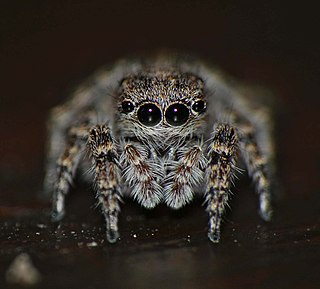
Afraflacilla is a genus of the spider family Salticidae. Most species are distributed in Eastern to Northern Africa and Australia, with two species found in Europe. This genus was for a time included in the genus Pseudicius, and the boundaries between both genera are disputed. In 2016 Jerzy Prószyński erected the genus Psenuc for some borderline species. The name Afraflacilla is combined from Africa, where most earlier described species were found, and FlacillaSimon, 1901, an obsolete salticid genus now called FlacillulaStrand, 1932. This genus name is in turn derived from Aelia Flaccilla, wife of Roman Emperor Theodosius I. Afraflacilla, Pseudicius, Festucula and Marchena are close relatives and form a monophyletic group.

Langelurillus is a spider genus of the family Salticidae. All the described species occur only in Africa.

Pseudicius is a genus of the jumping spiders first described by Eugène Simon in 1885. The name is combined of Greek pseudo "false" and the salticid genus name Icius. The small genus Wesolowskana should possibly be included in this genus. There is some dispute whether Afraflacilla is a distinct genus or should be included in Pseudicius. Festucula and Marchena are other close relatives, these genera form a monophyletic group.
Afraflacilla venustula is a jumping spider species in the genus Afraflacilla that lives in South Africa. It is related to Afraflacilla altera.
Hasarinella distincta is a jumping spider species in the genus Hasarinella that lives in South Africa. It was first described in 2013.
Afraflacilla imitator is a jumping spider species in the genus Afraflacilla that lives in South Africa. It was first described in 2013.
Pseudicius flabellus is a species of jumping spider in the genus Pseudicius that lives in South Africa. The male of the species was first described in 2013.
Pseudicius femineus is a jumping spider species in the genus Pseudicius that lives in South Africa. The female was first described in 2013.
Pseudicius dentatus is a jumping spider species in the genus Pseudicius that lives in South Africa. It was first described in 2013.
Habrocestum auricomum is a jumping spider species in the genus Habrocestum that lives in South Africa. It was first identified in 2013.
Microbianor furcatus is a jumping spider species of the genus Microbianor that lives in South Africa. The male was first identified in 2013.
Belippo pulchra is a jumping spider species in the genus Belippo that lives in South Africa. It was first identified in 2013.
Langelurillus cedarbergensis is a jumping spider species of the genus Langelurillus that lives in South Africa. Only the female has been described.
Dendryphantes matumi is a jumping spider species of the genus Dendryphantes that lives in South Africa.
Dendryphantes neethlingi is a jumping spider species of the genus Dendryphantes that lives in South Africa.
Rhene lingularis is a species of jumping spider in the genus Rhene that can be found in South Africa. The male was first identified in 2011. It is typical of the genus, and is small, dark brown and hairy. The spider is distinguished by its tongue-shaped embolus, from which its species name derives.
Rhene amanzi is a species of jumping spider in the genus Rhene. The male was first identified in 2013 and the female in 2018. It is small and dark brown, almost black, although the female is larger than the male. The species is named after the Amanzi Private Game Reserve in Free State, South Africa, which is the only place that it has been found. It differs from other spiders in the genus by the large triangular embolus found on the male and the shallow notch in the female's epigyne.
Rhene timidus is a species of jumping spider in the genus Rhene that lives in South Africa. Only the female has been described, in 2013. The spider is typical of the genus, but larger than Rhene facilis, with a relatively large abdomen measuring 3.5 mm (0.14 in) in length. It has a distinctive epigyne featuring spiralling ridges.
Tomomingi szutsi is a species of jumping spider in the genus Tomomingi that was first described in 2013. It is related to the similar Tomomingi holmi, but lives in the grasslands of the Soutpansberg mountain range in South Africa. The spider is small, brown and hairy.
Afraflacilla elegans is a species of spider in the family Salticidae. It is found in Zimbabwe and South Africa. Both the female and the male were first described in 2008, but the species initially placed in the genus Pseudicius, being moved to Afraflacilla in 2017.


